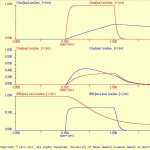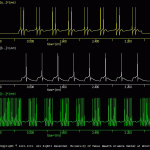Neural Networks
This subdirectory contains simulations that illustrate how to develop models of neural networks with SNNAP.
Half Center Oscillator
The goal of the present simulation was to illustrate how to construct a simple two neural network, which in turn, produces interesting patterns of neural activity. This two cell network with reciprocal inhibitory connections is often referred as an half-center oscillator and is a common motif in central pattern generators (CPG).
This simulation illustrates a common mechanism for generating patterned neural activity in a simple neural circuit. The Half_Center model contains two neurons, which make reciprocal inhibitory synaptic connections. The neurons incorporate 4 ionic conductances: fast Na and KU conductances, which underlying the spike, a leakage conductance and a persistent inward conductance, which drives spontaneous activity in the two neurons. In addition, the synaptic connections incorporate a simple form of synaptic plasticity (i.e., depression). It is this synaptic plasticity that allows the circuit to function as a central pattern generator (CPG). The duration of the alternating bursts of activity in the two cells can be altered by modifying the strength of the synaptic conductances (i.e., g_syn in the *.cs files).
Your simulation should look like the image in hlfCntrOsc.gif.
Oscillation
The goal of the present simulation is to illustrate how to construct a simple neural network, which in turn can produce interesting patterns of neural activity.
This simulation illustrates how a simple three-cell network might function as a central pattern generator (CPG).
The network of three cells and three synaptic connections is illustrated in Network.jpg.
Cells ‘a’ and ‘b’ have identical properties (i.e., they both use the same *.neu file). Cell ‘c’ is different only in that is uses a different leakage conductance (i.e. leak1.vdg vs. leak.vdg for cell ‘c’ vs. cells ‘a’ and ‘b’, respectively). This minor difference makes cell ‘c’ spontaneously active.
A depolarizing current is injected into cell ‘a’ 500 ms into the simulation. This causes cell ‘a’ to spike, which excites cell ‘b’ and inhibits cell ‘c’. When cell ‘b’ reaches threshold, it fires, which in turn inhibit cell ‘a’ and releases cell ‘c’ from inhibition.
This cycle of alternating excitation and inhibition produces patterned neural activity in this simple three cell network.
The results of this simulation are illustrated in Oscillation.gif.